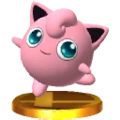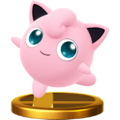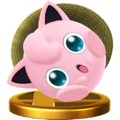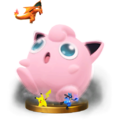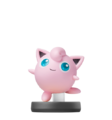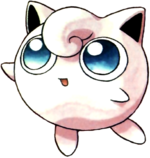Jigglypuff (SSB4)
| Jigglypuff in Super Smash Bros. 4 | |
|---|---|
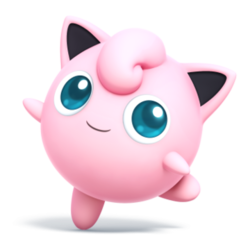 
| |
| Universe | Pokémon |
| Other playable appearances | in SSB in Melee in Brawl |
| Availability | Unlockable (3DS) Starter (Wii U) |
| Final Smash | Puff Up |
| Tier | J (55) |
Jigglypuff (プリン, Purin) is a playable character in Super Smash Bros. 4. It was formally added to the official website on November 5th, 2014, though the launch of the 3DS version in Japan two months prior meant that it was already known to be in the game. It was also seen several times during the Super Smash Bros. for Wii U: 50-Fact Extravaganza. Jigglypuff is once again voiced by Rachael Lillis (English) and Mika Kanai (Japanese) with the same voice clips from earlier installments. As in previous games, it also has different voice actresses in French and German due to name changes.
Jigglypuff ranks at 55th out of 56 characters on the tier list in J-tier, the second worst placement out of the cast and a slight drop from its already abysmal placement at 36th out of 38 characters in Brawl, previously third worst. Jigglypuff retains a strong air game, as it has nearly unrivaled aerial mobility along with multiple midair jumps and fast, long-duration aerial attacks, giving it good juggling ability. All these attributes facilitate a strong edge-guarding ability, for it can perform its signature Wall of Pain technique, and it has a potent finisher in its back aerial. Additionally, Jigglypuff's signature Rest attack has received some of the killing power that it greatly lost in Brawl. However, its weaknesses from the previous Smash titles remain. Jigglypuff suffers from a terrible ground game, due to its slow mobility, short reach, and a lackluster grab game with no grab combos to speak of. Jigglypuff also has severe issues KOing, with laggy finishers and Rest being very difficult to land without a hard read. Its endurance is unarguably the worst, as it is extremely floaty and has the lightest weight in the game, which is exacerbated by the new rage mechanic and weaker shields, the latter of which exploits its unusual shield jump. Overall, Jigglypuff's weaknesses drastically outweigh its strengths, and has seemingly not improved from Brawl, a fact that is made worse considering the vast amount of buffs that the majority of the returning veterans have received, resulting in Jigglypuff having extremely poor tournament representation and results.
How to unlock
Complete one of the following:
- Collect 30 different equipment items.
- Play 120 VS Matches.
Jigglypuff must then be defeated on Unova Pokémon League.
Jigglypuff does not need to be unlocked in the Wii U version.
Attributes
Jigglypuff is a character of the extremes. It has the second highest traction, the second highest air speed, one of the highest air acceleration values, the lowest falling speed and the lowest gravity. These stats make Jigglypuff a slippery opponent in the air and give it easily controllable ground movement. However, it has the slowest walking speed and the second slowest dashing speed, as well as the lowest weight and the weakest jumps. These make it unable to quickly traverse the stage on foot and susceptible to early KOs.
Jigglypuff's main strength is its formidable air game. Excluding back aerial, all of its aerial attacks have lingering hitboxes, and in the case of down aerial, multiple hits. Their duration is the primary reason Jigglypuff is deceptively difficult to challenge in the air, as opponents will most likely collide with an attack's final frames. Additionally, and with the exception of up aerial, all of its aerials have long melee range. These strengthen Jigglypuff's aerial approach and spacing capabilities even further, since it can zone opponents noncommittally. Finally, all of them have at least one area they excel in. Neutral aerial is strong and can easily gimp recoveries, forward aerial is the main component of the very well-known wall of pain, back aerial is one of the strongest of its kind and can KO reliably at 120%, up aerial spells trouble for any opponent that has issues dealing with juggling, and down aerial can be used as a highly damaging out of shield or anti-juggling option.
Another advantage Jigglypuff has is its recovery. Its unmatched floatiness, high air speed and multiple jumps allow it to recover from practically anywhere. Its high air acceleration also allows it to disorient opponents that attempt to edgeguard it. With the aid of Pound, it can also stall its recovery and protect its landing. Its tremendous offstage presence is what makes Jigglypuff fearsome at edgeguarding. With proper spacing and good timing, Jigglypuff can gimp all but the farthest reaching of recoveries without being put at risk. Particularly vulnerable characters include Ness and Little Mac. With recoveries that lack both speed and resilience, their performance against Jigglypuff revolves around maintaining stage control at all times.
Finally, Jigglypuff has a trump card in Rest, its signature move. Rest has very high knockback at all percentages, to the point where it can reliably KO any character at 70%. It hits on frame 2 with a flower effect and has full invincibility until frame 27. In addition to being an incredible punish, Rest is made even scarier by Jigglypuff's ability to true combo into the move. The easiest way to confirm one is with forward aerial. Hitting with the move's final frames will lead into an unavoidable Rest, which becomes even more potent if used in the air or with high rage. Depending on the opponent's falling speed, a jump may be necessary to reach them. Another reliable way to confirm one is by landing with up aerial. Should Jigglypuff land immediately after hitting the opponent, Rest can be landed without fail. This combo works optimally on platforms due to its limited percentage range and its ability to KO as low as 35%. Up tilt can also lead into Rest, which can be used to rack up at least 30%, but opponents get sent too far away after low percentages. Finally, retreating with down aerial can also work, but aside from being the hardest to perform, it is also the least likely to succeed. Other methods of safely using Rest involve crouching, buffering, a footstool jump or interrupting an opposing neutral attack, though few characters are vulnerable to these methods, and they usually require impeccable timing. For all its potential, however, Rest has the slowest interruptibility in the game, allowing Jigglypuff to move only after frame 230 and thus being a gamble to attempt in almost any circumstance.
Jigglypuff is also held back by three serious weaknesses. The most detrimental is its survivability. Jigglypuff's stats result in it having the shortest endurance in the game. As a result, it can be knocked out at 40% with a sufficiently strong attack. Unlike in Melee, Jigglypuff is unable to use its floatiness defensively outside of SDI. The introduction of rage is an additional burden, since opponents can send it flying even earlier. These drawbacks force Jigglypuff to play cautiously, as any damage taken can prove dangerous in the long run. Adding insult to injury, Jigglypuff's shield jump has enough force to KO it even from the very bottom of Palutena's Temple. This makes shielding very risky at low percentages, as the possibly survivable punishes normally received after a shield break are replaced by a guaranteed KO that can only be stopped by a ceiling.
Furthermore, Jigglypuff has a problematic ground game. While all of its ground moves are fast in proportion to their power, its crippling lack of range and slow ground approach prevent it from racking up large amounts of damage with only a few moves. This is further worsened when considering the utility of its grounded attacks. Neutral attack's incredible speed can lead into additional follow-ups, forward tilt is fast and highly damaging, up tilt can KO at unusually low percentages, and down tilt is a semi-spike with high base knockback. Forward smash has incredibly high knockback scaling (surpassing even Meta Knight's) and down smash has intangibility and the lowest launch angle of any other conventional semi-spike. Its grab game also has similar issues. While Jigglypuff has some of the fastest grabs in the game and the second most damaging set of throws (tied with Ganondorf and losing only to Bowser), the former have very short range and the latter lack any follow-up or KO capabilities. This also results in Jigglypuff being easily kept at bay by shields without usage of Pound's high shield damage.
Lastly, Jigglypuff has a half-useless special moveset. Rollout is a chargeable attack that can KO incredibly early no matter where it is used, but is incredibly predictable and immobilises Jigglypuff even after a successful hit. Sing has awkward timing, little range and does not work on aerial opponents. Its sleep effect can also be shortened with button mashing, reducing its otherwise devastating consequences. As a result, Jigglypuff has no reliable recovery move, instead relying on its remaining jumps and Pound to recover, making it easy to gimp in spite of its usual offstage comfort.
Jigglypuff is commonly considered the character that benefits the least from customs (along with Zero Suit Samus and King Dedede). Only three of its moves have utility that overall surpasses that of the originals. Relentless Rollout has much less power, but is much faster, hits multiple times and pierces opponents, making it less punishable and allowing it to be used as a recovery mix-up. Pound Blitz is slower and less powerful, but can still pressure shields while hitting multiple times and granting more momentum. Hyper Voice is better for protecting Jigglypuff, since it deals realistic knockback and works in the air. These benefits are marginal, however, and its other custom moves are disregarded in favour of the originals, due to their infamously low utility.
Overall, Jigglypuff can rack up damage quickly and KO opponents even faster, but can be ended just as quickly. As a result of its risky playstyle, it has notoriously low tournament representation and scarce singles results. It should be noted, however, that Jigglypuff is a force to be reckoned with in doubles. Its combination of evasiveness and strength are well-suited to this environment, as a teammate's attacks can give Jigglypuff many new options.
Changes from Brawl
Despite being the third worst character in Brawl, Jigglypuff has received a mix of buffs and nerfs in the transition from Brawl to SSB4, both directly and indirectly, but since none of its major flaws were addressed, it seems to have been nerfed overall.
Jigglypuff is, for the most part, adversely affected by universal gameplay changes. The removal of edge-hogging gives it a much harder time edge-guarding opponents, and while a number of characters have had their recoveries buffed, Jigglypuff's recovery was overall nerfed, as Pound grants less momentum. The addition of rage exacerbates its poor endurance, and it usually cannot survive long enough to make effective use of the mechanic, most notably with Rest, which had regained some of the power that it lost in Brawl. The changes to shield mechanics further compound its frailty, as Jigglypuff's unusual shield jump is now a much greater liability than in past games. Jigglypuff, however, benefits from hitstun cancelling only being possible at higher percents, as it is now able to perform true combos with its aerials again, but on the other hand, Jigglypuff's air game was nerfed, which makes up for that buff: its up, down, and especially back aerial are slower, with the latter having significantly increased ending and landing lag. Down aerial no longer auto-cancels in a short-hop, negating its use as an approach option. Jigglyuff has also lost the ability to perform two aerials in a short-hop. Lastly, its ground game was weakened, as its smash attacks deal less damage and knockback, while its faster dashing speed does not compensate for it. Its KOing ability is thus noticeably worse, and even with the changes to hitstun, it still has difficulty landing Rest.
However, Jigglypuff also received some buffs: most notably, and as mentioned above, Rest has regained most of its lost power from Brawl, and scales well with rage. Its neutral and back aerials have been buffed to KO at realistic percentages, at the cost of back aerial's noticeaeble speed loss. Also, its dash attack is now able to block weak attacks, giving it a new approach tactic and more tools to deal with projectiles. These changes, however, do not compensate for the nerfs it received. As such, Jigglypuff is arguably even worse than its appearance in Brawl, as none of its critical issues have been resolved and its few strengths in Brawl, its air game and edge-guarding ability, have been nerfed. Due to this, its representation and results in tournament play are still terrible; its tier position remains unchanged from Brawl, but with Ganondorf now rising past Jigglypuff, it has dropped from third lowest to second lowest. However, some players like FOW believe Jigglypuff, rather than Zelda, is the worst character in the game, as Zelda has at least seen rare use by Nairo and ven, and she was significantly buffed in update 1.1.5 while Jigglypuff was not.
Aesthetics
 Its appearance, much like the other returning playable Pokémon, has been updated to match recent appearances, notably Pokémon X and Pokémon Y. It is, like most other characters, more expressive than in previous iterations. It has brighter, more cyan colored eyes, which are also much smaller than in previous iterations and farther apart from each other, and a wider, higher-positioned mouth.
Its appearance, much like the other returning playable Pokémon, has been updated to match recent appearances, notably Pokémon X and Pokémon Y. It is, like most other characters, more expressive than in previous iterations. It has brighter, more cyan colored eyes, which are also much smaller than in previous iterations and farther apart from each other, and a wider, higher-positioned mouth. Jigglypuff's mouth is now closed and smiling, instead of being open as in previous games.
Jigglypuff's mouth is now closed and smiling, instead of being open as in previous games.
Attributes
 Shields in Smash 4 have less health and now take increased damage from an attack unlike in previous iterations which reduced damage by 30%, and since patch 1.1.1, shieldstun was increased, making shields notably more fragile than in Brawl. This hurts Jigglypuff as it possess a unique shield jump that instantly ceiling KO's it. As a result, shielding is now much riskier for Jigglypuff, especially against fighters who possess attacks with bonus shield damage (examples being Ryu, Donkey Kong, Ganondorf, Bowser, or Marth).
Shields in Smash 4 have less health and now take increased damage from an attack unlike in previous iterations which reduced damage by 30%, and since patch 1.1.1, shieldstun was increased, making shields notably more fragile than in Brawl. This hurts Jigglypuff as it possess a unique shield jump that instantly ceiling KO's it. As a result, shielding is now much riskier for Jigglypuff, especially against fighters who possess attacks with bonus shield damage (examples being Ryu, Donkey Kong, Ganondorf, Bowser, or Marth). Jigglypuff benefits from the changes to hitstun cancelling, as it allows to combo its opponents better, much like in Melee.
Jigglypuff benefits from the changes to hitstun cancelling, as it allows to combo its opponents better, much like in Melee. Like Kirby and Mr. Game and Watch, Jigglypuff also benefits from the universal size changes of all characters. It can now crouch under many more moves than it could before, which helps its defensive and punish game.
Like Kirby and Mr. Game and Watch, Jigglypuff also benefits from the universal size changes of all characters. It can now crouch under many more moves than it could before, which helps its defensive and punish game. The removal of edge-hogging and introduction of edge-trumping weakens Jigglypuff's edgeguarding game.
The removal of edge-hogging and introduction of edge-trumping weakens Jigglypuff's edgeguarding game. Jigglypuff has a lower short hop which prevents it from performing 2 aerials in a short hop.
Jigglypuff has a lower short hop which prevents it from performing 2 aerials in a short hop. Jigglypuff dashes slightly faster (1.1 → 1.155).
Jigglypuff dashes slightly faster (1.1 → 1.155).
Ground attacks
 Neutral attack links together reliably due to its new vertical trajectory.
Neutral attack links together reliably due to its new vertical trajectory. Neutral attack can no longer jab reset, removing Jigglypuff's most reliable way to safely set up Rest or a charged smash from a missed tech. The second hit also has increased cool down (IASA frame 17 → 20).
Neutral attack can no longer jab reset, removing Jigglypuff's most reliable way to safely set up Rest or a charged smash from a missed tech. The second hit also has increased cool down (IASA frame 17 → 20). Dash attack can no longer rebound, allowing it to block projectiles and most attacks, and making it safer as an approach option.
Dash attack can no longer rebound, allowing it to block projectiles and most attacks, and making it safer as an approach option. Down smash has reduced cool down (IASA frame 53 → 49).
Down smash has reduced cool down (IASA frame 53 → 49). Up smash has moderately reduced cool down (IASA frame 54 → 46).
Up smash has moderately reduced cool down (IASA frame 54 → 46). Forward smash (16/13% → 15/12%), up smash (15/13% → 14/12%) and down smash (12% → 11%). However, only forward smash's knockback scaling was compensated (103 → 115) while up smash and down smash were not properly compensated (up smash: 100 → 105, down smash: 66 → 69), making them weaker than in Brawl as a result.
Forward smash (16/13% → 15/12%), up smash (15/13% → 14/12%) and down smash (12% → 11%). However, only forward smash's knockback scaling was compensated (103 → 115) while up smash and down smash were not properly compensated (up smash: 100 → 105, down smash: 66 → 69), making them weaker than in Brawl as a result. The removal of DACUS slightly worsens its slow ground game and makes its up smash more situational.
The removal of DACUS slightly worsens its slow ground game and makes its up smash more situational.
Aerial attacks
 Neutral aerial deals 1% more damage (10% → 11%) with significantly improved knockback (20 base/90 scaling → 30/100).
Neutral aerial deals 1% more damage (10% → 11%) with significantly improved knockback (20 base/90 scaling → 30/100). Forward aerial deals 3% less damage (12% → 9%) with reduced knockback scaling (108 → 98) which removes most of its KO power.
Forward aerial deals 3% less damage (12% → 9%) with reduced knockback scaling (108 → 98) which removes most of its KO power. Forward aerial's reduced knockback makes it a better combo move akin to Melee.
Forward aerial's reduced knockback makes it a better combo move akin to Melee. Up aerial has added vertical reach and increased active frames (9 → 13 frames).
Up aerial has added vertical reach and increased active frames (9 → 13 frames). Up aerial has increased start up (8 → 9 frames) and moderately increased cool down (IASA 37 → 45).
Up aerial has increased start up (8 → 9 frames) and moderately increased cool down (IASA 37 → 45). Back aerial deals 1% more damage (12% → 13%) and has drastically increased knockback when hit with its sweetspot (10 base/90 scaling → 30/120).
Back aerial deals 1% more damage (12% → 13%) and has drastically increased knockback when hit with its sweetspot (10 base/90 scaling → 30/120). Back aerial has increased start-up (8 → 12 frames), reduced active frames (4 → 2 frames), moderately increased cool down (IASA 33 → 40), a worse auto-cancel window (frame 23 → 28) and increased landing lag (15 → 18 frames). This drastically hurts its utility as a safe spacing move and a Wall of Pain.
Back aerial has increased start-up (8 → 12 frames), reduced active frames (4 → 2 frames), moderately increased cool down (IASA 33 → 40), a worse auto-cancel window (frame 23 → 28) and increased landing lag (15 → 18 frames). This drastically hurts its utility as a safe spacing move and a Wall of Pain. Down aerial is harder to SDI out of.
Down aerial is harder to SDI out of. Down aerial deals less damage (16% → 14%), has increased start-up (frame 5 → 7) and no longer auto-cancels in a short hop.
Down aerial deals less damage (16% → 14%), has increased start-up (frame 5 → 7) and no longer auto-cancels in a short hop. Down aerial now knocks the opponent back, which gives Jigglypuff some new follow-up options and a new edgeguarding tool but removes some previous follow-up options to compensate.
Down aerial now knocks the opponent back, which gives Jigglypuff some new follow-up options and a new edgeguarding tool but removes some previous follow-up options to compensate.
Throws/other attacks
 Dash grab and pivot grab have faster startup (dash grab: frame 10-11 → 8-9, pivot grab: 10-11 → 9-10).
Dash grab and pivot grab have faster startup (dash grab: frame 10-11 → 8-9, pivot grab: 10-11 → 9-10). All grabs have lower ending lag (standing grab: 23 → 20 frames, dash grab: 29 → 24, pivot grab: 25 → 22).
All grabs have lower ending lag (standing grab: 23 → 20 frames, dash grab: 29 → 24, pivot grab: 25 → 22). Pummel comes out faster and deals 0.1% more damage (3% → 3.1%).
Pummel comes out faster and deals 0.1% more damage (3% → 3.1%). Jigglypuff now uses its other arm to pummel, instead of its hair curl.
Jigglypuff now uses its other arm to pummel, instead of its hair curl. Both floor attacks deal 1% more damage (6% → 7%).
Both floor attacks deal 1% more damage (6% → 7%).
Special moves
 Rollout travels faster and deals more damage when travelling along slopes, such as in Green Hill Zone and Corneria. It can also bypass certain counter moves.
Rollout travels faster and deals more damage when travelling along slopes, such as in Green Hill Zone and Corneria. It can also bypass certain counter moves. Rollout deals much less damage and knockback. Jigglypuff can no longer move in midair after striking an opponent, weakening its recovery potential.
Rollout deals much less damage and knockback. Jigglypuff can no longer move in midair after striking an opponent, weakening its recovery potential. Pound benefits from the weaker shields in Smash 4, as it deals significant shield damage (11% + 20% bonus shield damage). It is capable of breaking a shield that is below 70% of its health.
Pound benefits from the weaker shields in Smash 4, as it deals significant shield damage (11% + 20% bonus shield damage). It is capable of breaking a shield that is below 70% of its health. Pound's reduced momentum weakens its horizontal recovery capabilities.
Pound's reduced momentum weakens its horizontal recovery capabilities. Rest deals 5% more damage (15% → 20%) which greatly increases its knockback despite its lower knockback scaling (75 → 66). It additionally has a larger hitbox (2.6 → 3.4 units) and reduced cool down (IASA 250 → 230), improving its utility.
Rest deals 5% more damage (15% → 20%) which greatly increases its knockback despite its lower knockback scaling (75 → 66). It additionally has a larger hitbox (2.6 → 3.4 units) and reduced cool down (IASA 250 → 230), improving its utility. The implementation of Blast KOs from the upper blast line makes Rest less safe as a finishing move, possibly allowing the opponent to respawn quickly and providing a chance to punish.
The implementation of Blast KOs from the upper blast line makes Rest less safe as a finishing move, possibly allowing the opponent to respawn quickly and providing a chance to punish.
 Conversely, the lengthening of Screen KOs hinders an opponent's chance to punish Jigglypuff, as they are just as long as Star KOs.
Conversely, the lengthening of Screen KOs hinders an opponent's chance to punish Jigglypuff, as they are just as long as Star KOs.
 Puff Up increases Jigglypuff's size significantly to where most stages are entirely covered, significantly increasing its reach.
Puff Up increases Jigglypuff's size significantly to where most stages are entirely covered, significantly increasing its reach. Puff Up deals 1% less damage (18% → 17%) upon contact.
Puff Up deals 1% less damage (18% → 17%) upon contact. Puff Up now has a solitary hitbox once Jigglypuff reaches its maximum size and roars, rather than using multiple hitboxes during the shrink that occurs following the roar. This new damaging hitbox causes reasonable knockback (dependent on foe damage) at a Sakurai angle rather than simply hurling the foe away with a windbox (dependent on proximity to Jigglypuff's center mass). With the shrink hitboxes removed, Jigglypuff cannot chain hits against foes trapped against a wall for massive damage and mounting knockback.
Puff Up now has a solitary hitbox once Jigglypuff reaches its maximum size and roars, rather than using multiple hitboxes during the shrink that occurs following the roar. This new damaging hitbox causes reasonable knockback (dependent on foe damage) at a Sakurai angle rather than simply hurling the foe away with a windbox (dependent on proximity to Jigglypuff's center mass). With the shrink hitboxes removed, Jigglypuff cannot chain hits against foes trapped against a wall for massive damage and mounting knockback. Puff Up also now makes the stage shake. Additionally, Jigglypuff's eyes now continue to glow yellow from the Final Smash effect when performing Puff Up.
Puff Up also now makes the stage shake. Additionally, Jigglypuff's eyes now continue to glow yellow from the Final Smash effect when performing Puff Up.
Update history
Despite its numerous flaws, Jigglypuff has not directly been changed in updates so far. The changes to shield mechanics in 1.1.0 and 1.1.1 (hitlag modifiers now applying in shields and the increase in shieldstun) have made Jigglypuff more susceptible to being instantly KOed by having its shield broken, and as such, Jigglypuff is significantly frailer than in previous iterations. However, it also makes Jigglypuff's attacks slightly safer on shield (most notably back aerial) and benefits Pound's shield damaging capabilities, improving its limited approach options.
 The instant reversal glitch of Rollout (by holding away while landing with Rollout when facing right) has been removed.
The instant reversal glitch of Rollout (by holding away while landing with Rollout when facing right) has been removed.
 This slightly hinders Rollout's utility.
This slightly hinders Rollout's utility.
 There was previously an issue where if Jigglypuff landed with rollout while facing left and holding away, Jigglypuff could not turn around at any point after landing with Rollout and the move lacked a hitbox. This was fixed.
There was previously an issue where if Jigglypuff landed with rollout while facing left and holding away, Jigglypuff could not turn around at any point after landing with Rollout and the move lacked a hitbox. This was fixed.
Moveset
| Name | Damage | Description | ||
|---|---|---|---|---|
| Neutral attack | 3% | Two very quick, yet extremely short ranged slaps. Can act as a pseudo-jab cancel into certain moves, particularly Pound, a grab or another jab. | ||
| 3% | ||||
| Forward tilt | 10% | Spins once while kicking. Short ranged. | ||
| Up tilt | 9% | Lifts its foot behind it, attacking upward. Surprisingly powerful, it can KO at 140%, although it won't hit opponents in front of Jigglypuff, and has some start-up. | ||
| Down tilt | 10% | Ducks down and sticks its foot out. Good for setting up edgeguards. | ||
| Dash attack | 12% | Dives forwards. Decently quick with good knockback for a dash attack, although Jigglypuff's slow dashing speed somewhat limits its utility. Good KO move near the ledge, usually starting at 130%. Its hitbox blocks opposing attacks. | ||
| Forward smash | 15% (clean), 12% (late) | Slides forward while keeping foot stuck out. Powerful, but has considerable ending lag. Begins to KO at 90%. | ||
| Up smash | 14% (clean), 12% (late) | Headbutts upward. Most effective if the foe is behind Jigglypuff. Begins to KO at 130%. | ||
| Down smash | 11% | Puffs downward, kicking to both sides. Jigglypuff spins while charging the attack. It is a semi-spike, but difficult to connect with. Pushes opponents quite far. | ||
| Neutral aerial | 11% (clean), 6% (late) | Sticks foot out, shrinking in on itself a little. A sex kick with a long-lasting late hitbox. One of Jigglypuff's best moves, as it is very safe and has decent knockback when sweetspotted. Commonly used to block opponents from the ledge, or to end a Wall of Pain. | ||
| Forward aerial | 9% (clean), 6% (late) | Dropkicks forward. Somewhat weak knockback, but good for spacing and can be used for a Wall of Pain. Has a lingering hitbox, though not as long-lasting as neutral aerial's. | ||
| Back aerial | 13% | Spins once backward and kicks. Jigglypuff's slowest aerial, and unlike the others it lacks a lingering hitbox, but it has strong knockback while still being reasonably quick, making it a potent finisher. KOs from center stage at 120%. | ||
| Up aerial | 9% | Waves upward. Very short range, but the hitbox lingers without losing strength. Good for juggling and sharking. | ||
| Down aerial | 1.5% (hits 1-8), 2% (hit 9), 14% if all hits connect | A spinning drill kick. Good out of shield option and somewhat effective as an anti-juggling tool, but it is unsafe to land with, as its landing lag is punishable even on hit. | ||
| Grab | — | Hooks opponent. Very low range, though it has low ending lag. | ||
| Pummel | 3% | Slaps opponent. Its decent speed combined with its power makes it the second best pummel in the game, behind Kirby (third when counting Lucario at max aura). | ||
| Forward throw | 5% (hit 1), 5% (throw) | Puffs once, hitting opponent forward. Low knockback, but has low ending lag. | ||
| Back throw | 10% | Back suplexes opponent. Good for putting opponents off the ledge to edgeguard with its aerials. | ||
| Up throw | 10% | Spins once and sends opponent up. Jigglypuff's strongest throw, though it requires the use of stages with platforms and high rage to net a KO. | ||
| Down throw | 4% (hit 1), 6% (throw) | Rolls back and forth on its opponent, then sends them straight up. | ||
| Forward roll Back roll Spot dodge Air dodge |
— | — | ||
| Techs | — | — | ||
| Floor attack (front) Floor getups (front) |
7% | Spins its legs around while getting up, kicking in front and behind it. | ||
| Floor attack (back) Floor getups (back) |
7% | Kicks in front of it, then behind it. | ||
| Floor attack (trip) Floor getups (trip) |
10% | Spins on the ground while kicking both sides, similar to Captain Falcon's frontal floor attack. | ||
| Edge attack Edge getups |
6% | Does a flip kick onto the stage. | ||
| Neutral special | Default | Rollout | 14% fully charged | Jigglypuff rolls forward to attack, similar to Yoshi's Egg Roll. The move's power, range, and speed can be increased by charging it. When it is fully charged, Jigglypuff will say "Jiggly!" and briefly flash. Hitting a non-shielding foe will cause Jigglypuff to rebound, unable to do anything else until landing or hit by something. This makes Rollout dangerous to use off-stage, or at an edge, since the rebound will cause Jigglypuff to spin helplessly down to the bottom blast line. |
| Custom 1 | Relentless Rollout | 1-2% (loop) | This Rollout charges up much quicker, and travels faster and farther. The move doesn't end if it hits someone, instead rolling through them and dealing 1% or 2% of damage at max charge for every time it makes contact. Much better for recovery than the default version. | |
| Custom 2 | Raging Rollout | 16% | The charge time is nearly twice that of the normal version, but Jigglypuff rolls faster and deals more knockback. This attack is also unblockable High endlag and meager horizontal distance make this custom move unsuited for recovery. Jigglypuff also cannot turn around. | |
| Side special | Default | Pound | 11% | Jigglypuff punches forward, causing moderate knockback. The punch's momentum also sends Jigglypuff sideways, making it one of the two special moves it can use to recover. It also does a high amount of shield damage and has a surprisingly big and long-lasting hitbox. |
| Custom 1 | Sideways Pound | 7% | In exchange for recovery and damage, this Pound's knockback sends the foe on a semi-spike trajectory. | |
| Custom 2 | Pound Blitz | 9% | Jigglypuff's slap hits the foe multiple times, granting it more power, shield damage, and recovery momentum. However, it has slightly less damage and much greater endlag. | |
| Up special | Default | Sing | 0% | Jigglypuff sings its trademark song, putting nearby opponents to sleep. The more damage they have taken, the longer they'll slumber, making them susceptible to free shots (like smash attacks or Rest). However, the song is short-ranged and makes Jigglypuff itself vulnerable to free shots as well. It does not travel any vertical distance. Because of this, Sing is almost never used in competitive play. |
| Custom 1 | Hyper Voice | 3% (first and second sound waves), 5% (third sound wave) | Jigglypuff uses a louder voice while singing, inflicting damage on foes in lieu of putting them to sleep. The first sound wave causes enemies to flinch, the second does not, and the third has the most range as well as decent knockback. Slower than Sing. | |
| Custom 2 | Spinphony | 1% (second sound wave), 2% (third sound wave) | Startup and execution is extremely slow, but Jigglypuff sings a song that has the power to flip opponents, similar to Mario's Cape, but it only flips them if they're facing Jigglypuff. Does damage like Hyper Voice, but is much weaker, with the first sound wave doing no damage at all. Not good for edge-guarding, because it makes the foe flinch, allowing them to use a second recovery move. | |
| Down special | Default | Rest | 20% (hit), 36% from the flower effect | Falls asleep. Launches opponents upwards if timed properly and used at point-blank range. The move has almost no startup lag (1 frame) and catastrophic vertical knockback if landed (KO'ing at 60%), and puts a flower on the victim's head. If Rest misses, it has dire consequences: Jigglypuff is left completely open for roughly 5 seconds, which is more than enough time for the opponent to launch a devastating counterattack. It still has a chance to be punished if the opponent is Blast KOed at the upper blast line rather than Star KOed or Screen KOed, though they must be quick. Jigglypuff gains invincibility for a few frames when the move is used (before its eyes close) which can initially prevent counterattacks from hitting Jigglypuff, though this really isn't all that useful considering the move's extreme ending lag. |
| Custom 1 | Leaping Rest | 11% | Jigglypuff jumps into the air while falling asleep. It has less strength than normal, but has quicker startup and can still reliably score KO's. Since Jigglypuff is sleeping, it cannot grab ledges while jumping, making it an ineffective recovery as with the normal Rest. | |
| Custom 2 | Wakie Wakie | 14-15%, 5% self-inflicted damage | Jigglypuff pushes back opponents while sleeping, and creates an explosion upon waking up. The move loses its tremendously powerful (but tiny) hitbox at the start and inflicts 5% recoil damage, but Jigglypuff takes a shorter nap and the explosion inflicts 14-15% fire damage. | |
| Final Smash | Puff Up | 17% | Jigglypuff rapidly swells up to a gargantuan size, and sends all foes near it flying away horizontally with a mighty "JIGGLY!!!" before quickly deflating back to normal size. Jigglypuff's size is so great when inflating, its body completely takes up smaller stages and some medium sized ones, making the Final Smash nearly inescapable. | |
On-screen appearance
- Emerges from a Poké Ball.
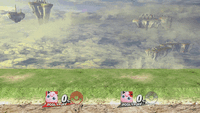
|
|---|
Taunts
- Up taunt: Happily spins in place on one foot then looks and winks at the camera inflated, all while crying "Jigglypuff!" (プリプリーン!). This is its taunt since Melee.
- Side taunt: Twirls around then poses while looking away at the opposite side it is facing, then blinks twice in a cute fashion.
- Down taunt: Deflates and falls to the ground, flattened, then quickly inflates up again. This taunt is similar to its fainting animation in home-console Pokémon games like Pokémon Battle Revolution.
| Up taunt | Side taunt | Down taunt |
|---|---|---|
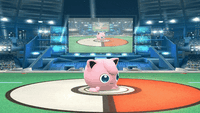
|
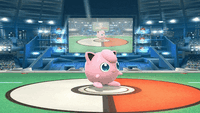
|
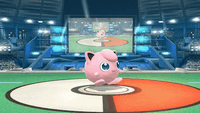
|
Idle Poses
- Looks at its side while jumping.
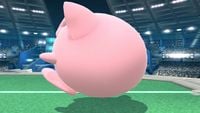
|
|---|
Crowd cheer
| English | Japanese | |
|---|---|---|
| Cheer | ||
| Description | Jigglypuff! | Pur-in! |
| Pitch | Group chant | Female |
Victory poses
- Jumps twice, then does a backflip and looks towards the screen.
- Shivers and suddenly jumps up, rolling back and forth on its back.
- Sleeps and then suddenly wakes up. It continues to drift off to sleep and wake up groggily.
 |
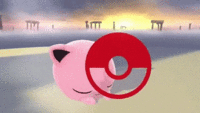 |
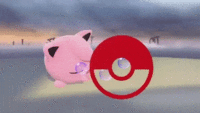
|
|---|
In competitive play
Official Custom Moveset Project
| Character | Custom sets available | ||||
|---|---|---|---|---|---|
| 1121 | 1122 | 1321 | 1322 | 2121 | |
| 2122 | 2321 | 2322 | 3121 | 1221 | |
Notable players
Active
Inactive
Trophies
- Jigglypuff
This Normal- and Fairy-type Pokémon is best known for its soothing singing, which quite often puts foes to sleep. In this game, Jigglypuff fights best in the air, and can even jump six times in a row. The downside, though, is that Jigglypuff's so light, just about any opponent could launch it in their sleep!
- Jigglypuff (Alt.)
When you use the Rest down special, you go into a deep sleep, as you'd expect. But if anyone is touching you when you do it, you'll inflict a lot of damage and launch them directly upwards. They even continue to take damage afterwards. It's not easy to pull off, though, and falling asleep leaves you open to attacks, so be careful.
- Puff Up
When Jigglypuff uses its Final Smash, it starts to grow bigger. And bigger. And bigger! Before you know it, Jigglypuff will have completely taken over the screen-and there's no way to make it stop. On smaller stages, fighters may find there's nowhere left to stand! At near full size, Jigglypuff will damage and launch anyone it touches.
It doesn't deal a lot of damage or launch opponents a long way. No, when Jigglypuff uses its Final Smash, it gets...bigger. And bigger. And bigger. Before you know it, Jigglypuff will have completely taken over the screen - and there's no way to make it stop. On smaller stages, fighters may find there's nowhere left to stand!
- JigglypuffAllStarTrophy3DS.png
Alt. (3DS)
In Event Matches
Solo Events
- All-Star Battle: Secret: Jigglypuff is one of the opponents fought in this event. All opponents are characters that have been unlockable in previous Super Smash Bros. games.
- It's Past Your Bedtime!: Jigglypuff must make Ness, Bowser Jr., and Toon Link fall asleep at the same time by using Sing.
Co-op Events
- The Ultimate Battle: Two players select a character and must defeat the entire roster.
Alternate costumes

| |||||||

|

|

|

|

|

|

|

|
Gallery
Jigglypuff's amiibo.
In the process of throwing Captain Falcon.
Using Puff Up.
Taunting while being spotted by 5-Volt on Gamer.
Trivia
- Super Smash Bros. for Wii U is the first Smash game where Jigglypuff is a starter character. As a result, Jigglypuff had appeared in various official screenshots and videos without acknowledgement (such as the October 2014 Wii U Direct) before its official reveal.
- Jigglypuff was the last character overall to be fully confirmed on the Smash 4 website before the initial release of the Wii U version and the last of the "Original 12" to be announced.
- Jigglypuff's official artwork pose is a mirrored version of its pose from its official artwork from Pokémon Red and Green. Super Smash Bros. 4 is also the only Smash Bros. game to not have Jigglypuff fully face the screen in its official art.
- While Jigglypuff's textures are completely unique in Super Smash Bros. for Nintendo 3DS, the actual 3D model is extremely similar to the model used in Pokémon X and Y.[1]
- While most Fighter trophies are sorted by debut appearance, and then by unlock-ability within the type sorting, Jigglypuff is different in that it is sandwiched between the Brawl characters and the Smash 4 characters in the list.
- If done with the correct timing, Jigglypuff can avoid damage with its down taunt. Also, if its down taunt is used next to a cannon in the stage builder, Jigglypuff will be launched by said cannon.
- Jigglypuff is the only starter character in Super Smash Bros. for Wii U who has a challenge exclusive to it that cannot be unlocked with a Golden Hammer.
- Jigglypuff, Captain Falcon, and Yoshi are the only characters who have voice clips that are used in all five Super Smash Bros. installments.
- Jigglypuff is also the only non-DLC character in SSB4 to have only one blastline KO voice clip.
- Ness and Jigglypuff are the only "Original 12" characters to not appear in any newcomer poster art.
- Jigglypuff's mouth will randomly shift between its "open" and "closed" animations when asleep. However, this is only an aesthetic bug with no gameplay issues.
References
| Fighters in Super Smash Bros. 4 | |
|---|---|
| Veterans | Bowser · Captain Falcon · Charizard · Diddy Kong · Donkey Kong · Dr. Mario · Falco · Fox · Ganondorf · Ike · Jigglypuff · King Dedede · Kirby · Link · Lucario · Lucas · Luigi · Mario · Marth · Meta Knight · Mewtwo · Mr. Game & Watch · Ness · Olimar · Peach · Pikachu · Pit · R.O.B. · Roy · Samus · Sheik · Sonic · Toon Link · Wario · Yoshi · Zelda · Zero Suit Samus |
| Newcomers | Bayonetta · Bowser Jr. · Cloud · Corrin · Dark Pit · Duck Hunt · Greninja · Little Mac · Lucina · Mega Man · Mii Fighter (Mii Brawler · Mii Gunner · Mii Swordfighter) · Pac-Man · Palutena · Robin · Rosalina & Luma · Ryu · Shulk · Villager · Wii Fit Trainer |
